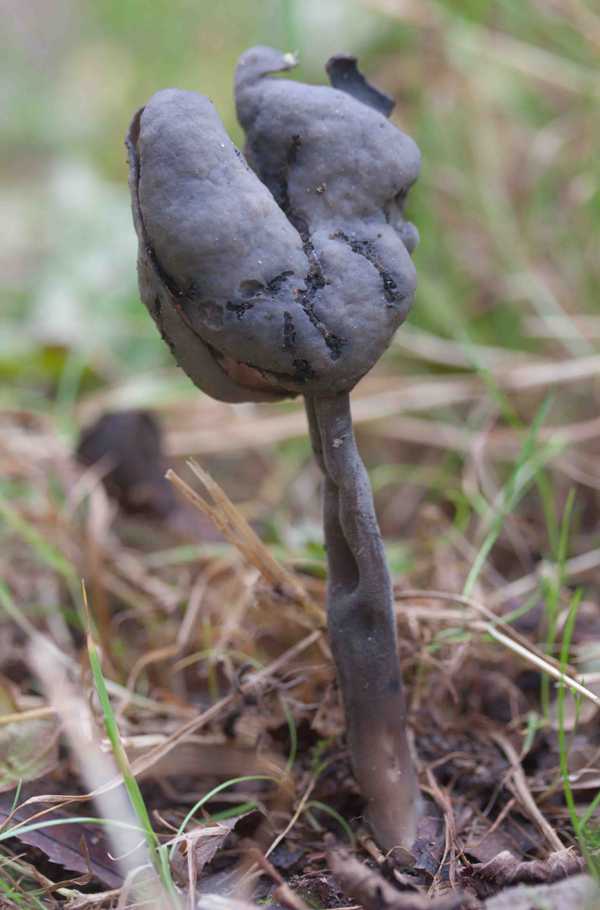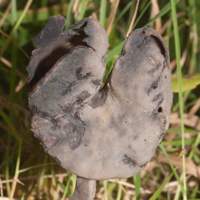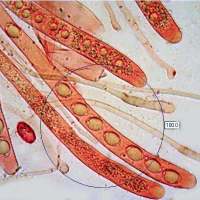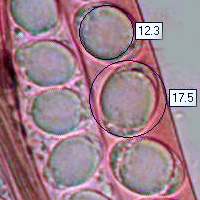Trees Birds Mammals Fish Amphibians Reptiles
Wild Algarve
Bookshop
Helvella atra J König.
Phylum: Ascomycota - Class: Pezizomycetes - Order: Pezizales - Family: Helvellaceae
Distribution - Taxonomic History - Etymology - Identification - Culinary Notes - Reference Sources

Helvella atra is one of several 'saddle fungi'
that appear in forests, particularly beside footpaths. These rather uncommon ascomycetes are dull, burnt-looking and contorted like dried up leaves and so they are very easily
overlooked. (Picture: Rob Petley-Jones)
Like their close relatives the morels, saddle fungi may possibly have the capacity to form mycorrhizal relationships with woodland trees, but it is also fairly clear that they can live as saprobes, feeding on dead woody debris. This particular species, which in Britain usually occurs either singly and in small groups, is a gregarious and very common fungus in some parts of central Europe.
Helvella atra seems to favour sandy alkaline soil rather than acidic soil or heavy clay, and although most often found in forests it is certainly not confined to woodland.
Distribution
A rare find - probably exacerbated by its drab and inconspicuous colouring - Helvella atra is nevertheless widespread across Britain and Ireland. This saddle fungus occurs also throughout mainland Europe and is recorded from many parts of North America.
Taxonomic history
In 1770, when Johann Gerhard König (1728 - 1785) described this saddle fungus he gave it the scientific name Helvella atra, and that name is still generally accepted today.
Synonyms of Helvella atra include Leptopodia atra (J. König) Boud., and Helvella nigricans Pers.
Etymology
Helvella is an ancient term for an aromatic herb. The specific epithet atra means black.
Identification guide
 |
Fruitbody
This species is very variable in size. Up to 8cm tall with a contorted cap 0.5 to 3cm across and 0.5 to 2cm tall, usually with two upward-projecting lobes; the exterior (fertile, asci-bearing) surface is grey-brown or black, while the inner (infertile) surface is somewhat paler. The stem is grey-brown, 3 to 8mm in diameter, thickening somewhat towards the base, and 4 to 8cm long; not usually with multiple deep furrows. |
 |
Asci
Asci are typically 250 x 17μm. Each ascus contains eight spores.
Paraphyses
Cylindrical, 4-7.5μm diameter, inflated slightly towards the tips.
|
 |
Spores
Ellipsoidal, smooth, 16-19 x 10-13μm; hyaline.
Spore print
White. |
Odour/taste |
Faint pleasant odour; no distinctive taste. |
Habitat & Ecological role |
In small groups in mixed woodland, usually on sandy alkaline soil; occasionally in scrubby grassland. |
Season |
Summer and autumn. |
Occurrence |
Infrequent or rare in Britain and Ireland, Helvella atra seems to be rather more common in some southern European countries. |
Similar species |
Helvella lacunosa also has a grey-brown or black cap but it is readily differentiated from Helvella atra by its more massive and deeply grooved stem.
Helvella elastica is of similar size; it has a beige cap that is less angular, and its stem is white. |
Culinary Notes
All Helvella fungi - of which at least 26 species have been recorded in Britain - should be considered as being inedible and possibly poisonous (and there is even some suggestion that they may be carcinogenic). These ascomycetous fungi are closely related to the potentially lethal False Morel, Gyromitra esculenta.
Reference Sources
Fascinated by Fungi, 2nd Edition, Pat O'Reilly 2016, reprinted by Coch-y-bonddu Books in 2022.
Dennis, R.W.G. (1981). British Ascomycetes; Lubrecht & Cramer; ISBN: 3768205525.
Breitenbach, J. & Kränzlin, F. (1984). Fungi of Switzerland. Volume 1: Ascomycetes. Verlag Mykologia: Luzern, Switzerland.
Medardi, G. (2006). Ascomiceti d'Italia. Centro Studi Micologici: Trento.
British Mycological Society (2010). English Names for Fungi
Dictionary of the Fungi; Paul M. Kirk, Paul F. Cannon, David W. Minter and J. A. Stalpers; CABI, 2008
Taxonomic history and synonym information on these pages is drawn from many sources but in particular from the British Mycological Society's GB Checklist of Fungi.
Acknowledgements
This page includes pictures kindly contributed by Simon Harding and Rob Petley-Jones.
Top of page...
Fascinated by Fungi. Back by popular demand, Pat O'Reilly's best-selling 450-page hardback book is available now. The latest second edition was republished with a sparkling new cover design in September 2022 by Coch-y-Bonddu Books. Full details and copies are available from the publisher's online bookshop...